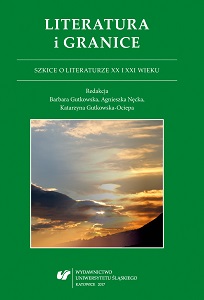
Między awangardyzmem a egzystencją. O obrazie wojny w wierszu Józefa Czechowicza daleko
The article Between avant-gardism and existence. On the image of war in the poem „daleko” by Józef Czechowicz is an attempt at tracing the breakthrough that occurred in the poetry of the author of nuta człowiecza with relation to his rejection of optimistic worldview formed in the spirit of Cracovian avant-garde, and his adopting a distinct, nearcatastrophism tonality, which in time became a model for the works of the so-called second avant-garde. The turning-point seems to be the publishing of Czechowicz’s second volume, dzień jak co dzień. The article analyses the opening poem from this volume, entitled daleko. This work appears to be a meditation upon the condition of a man put against a borderline situation, as is the experience of war. Paradoxically, this work in not strictly a war poem, however, the imagery of Czechowicz discerns the nightmare of war in every, even neutral, landscape. This “infection” with war seems to correspond with the state of “total mobilization” observed by Ernst Jünger, which eliminates the boundary between the state of war and peace. In this situation, the sense of anxiety seems to dominate in this work, and the verbalized fear situates it in the spirit that is close to existentialism in its lay variant. In such a conceptualization, the subject of the poetic afterthought in Czechowicz’s work becomes nothingness, so strange for the doctrine of the Cracovian avant-garde, and later achievements of the author of Nic Więcej only support this thesis.
More...
